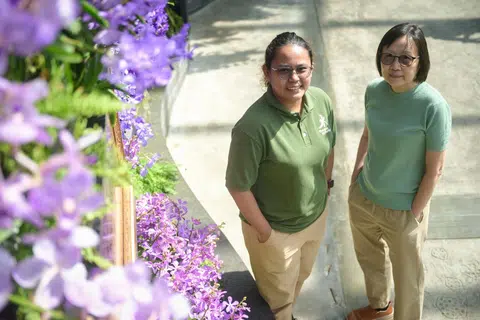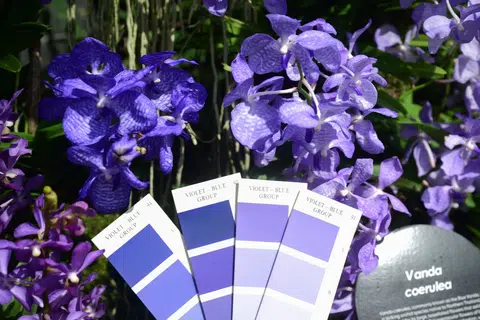Is the Blue Vanda blue or purple - what do you see?
An orchid known for its deep colour and medicinal uses is one of the highlights of a new floral display at Gardens by the Bay.
The Vanda coerulea, also known as blue orchid or Blue Vanda, was first identified in 1847. The flower grows in cooler regions, from forests in the Himalayan regions to South-east Asia.
Its juice is used in eye drops to treat glaucoma and cataracts.
The orchid, with a distinct tessellated pattern on its petals, is featured in Orchids from the Land of Smiles, a display at Gardens by the Bay's Cloud Forest conservatory which began on Feb 14.
The display - a collaboration with the Royal Thai Embassy marking 60 years of diplomatic relations between Singapore and Thailand, and the 60th year of the Republic's independence - features native Thai species of orchids or those with origins that can be traced back to Thailand.
The South-east Asian nation is reputed to be home to more than 1,000 types of orchids.
The flower's species name, coerulea, is derived from the Latin caeruleus, which means "sky blue". But many who see the Blue Vanda perceive it to be purple.
So what colour is it really?
Like the photograph of a dress which went viral 10 years ago because some saw it as blue with black lace and others as white with gold lace, several factors influence whether you see the Blue Vanda as blue or not.
"Is it really blue? It depends on your eyes," said Ms Siti Nurziana Yacob, research and horticulture manager at Gardens by the Bay.
Human eyes are less sensitive to violet and near-ultraviolet light, she explained, making certain shades of blue appear more purple.
Environmental factors such as natural daylight and artificial lighting can also affect how people see the orchid, she added.
Less than 10 per cent of the 280,000 species of flowering plants produce flowers which appear blue.
True blue pigment does not exist in plants, unlike for the colours red, yellow and orange.

Instead, the colour occurs when anthocyanins - water-soluble pigments found in plants - in the orchids react to different levels of acidity, with blue tones produced by higher pH levels.
Anthocyanins are unstable, which result in the hues of the flowers changing, said Ms Nurziana.
"It can even make blue flowers turn white," she added.
The stability and intensity of these pigments are also influenced by factors such as interactions with sugars, metal ions such as aluminium, and co-pigments - compounds which are colourless to the human eye but can influence the colour of anthocyanins - all of which can help enhance or maintain the blue colour in the flowers.
As for why horticulturalists consider the Vanda coerulea to be blue, Ms Nurziana noted that the orchid matches shades classified as blue in the colour chart of Britain's Royal Horticultural Society, the world's leading horticultural organisation.
With 920 colours, the chart was introduced in 1966 to help identify and classify flower and plant colours.

Specifically, the Vanda coerulea's hue matches violet-blue shades on the chart - meaning it falls somewhere in between these two colours.
The chart acts as a reference not just for horticulturalists, but also orchid growers.
Regardless of whether it is truly blue or purple, Vanda coerulea's colour makes it a popular choice among growers, with the flower and its hybrids making up about a third of the 60 varieties of orchids at Orchids from the Land of Smiles.
Orchids on display include Vandachostylis Jairak Sapphire - a hybrid of the Vanda coerulea and the Vanda coelestis which was bred and registered in 2018 - as well as Vanda Pachara Delight, a hybrid of the Vanda Gordon Dillon and the Vanda Karulea, which itself is a hybrid progeny of the Vanda coerulea.
Zhaki Abdullah for The Straits Times